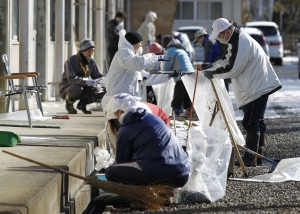|
Japan's Post-Fukushima
Earthquake Health Woes Go Beyond Radiation Effects

Fukushima Nuclear Plant
EMF Computer Protection
Magnetic Field Detector
By Katherine Harmon
March 2, 2012
Heart disease and depression are likely to claim more lives than
radiation after the earthquake, tsunami and nuclear
accident, experts say Volunteers at Minamisoma city,
Fukushima pref. The city was severly damaged by the Tsunami
of Japan Earthquake and Fukushima Daiichi nuclear plant
accident.
After the March 11, 2011, earthquake and tsunami crippled Japan's
Fukushima Daiichi nuclear power plant, worry about the
unfolding nuclear accident quickly commandeered
international headlines. Even after the situation was
brought under relative control over subsequent days and
weeks, public concern hung on the threat of radiation almost
more than it did than on the tsunami and earthquake
themselves, which had killed more than 15,850 people and
displaced at least 340,000 more.
A year out, public health experts agree that the radiation fears
were overblown. Compared with the effects of the
radiation exposure from Fukushima, "the number of
expected fatalities are never going to be that large," says
Thomas McKone, of the University of California, Berkeley,
School of Public Health.
And some, including Richard Garfield, a professor of Clinical and
International Nursing at Columbia University's Mailman
School of Public Health, go a step further. "In terms of the
health impact, the radiation is negligible," he says. "The
radiation will cause very few, close to no deaths." But that
does not mean that the accident has not already caused
wide-reaching health issues. "The indirect effects are
great," Garfield says.
Reacting over radiation. The prospect of invisible
radioactive material contaminating the air and ground is
terrifying especially for a country that experienced two
nuclear bomb attacks in 1945.
In the aftermath of the earthquake the situation seemed dire, as
buildings crumbled and workers were exposed to lifetime
doses of radiation in a few hours. But in retrospect, the
power plant's malfunction was relatively well contained. The
reactor shut down, as designed, at the time of the
earthquake. "It was nowhere near as complex of a release as
Chernobyl, which was everything from the core of the
reactor," says Peter Caracappa, a radiation safety officer
and clinical assistant professor of nuclear engineering at
Rensselaer Polytechnic Institute in Troy, N.Y. "This was a
slow release," he adds, and it was limited to a few
radioactive materials, including iodine 131, which has a
half-life of just eight days and therefore does not lead to
long-term contamination. And for other isotopes, such as
cesium 134 (three-year half-life) and cesium 137, (30
years), levels can be easily detected and dangerous areas
kept clear.
And the Japanese government, although criticized immediately after
the accident for providing spotty information, actually gave
relatively good instructions to local residents. In
particular, it wisely asked people to shelter in place
before evacuating potentially dangerous areas, says Kathryn
Higley, head of the Nuclear Engineering and Radiation Health
Physics department at Oregon State University.
The government, armed with reliable maps of where radiation levels
were highest, has tailored its advice to local
circumstances. Owing to the weather patterns just after the
accident, most of the radioactive fallout landed northwest
of the Fukushima complex. So for that area, the government
has kept the recommended evacuation distance at 30
kilometers. But to the south, a distance of 20 kilometers
sufficesand even that, Caracappa says, is more for
logistical reasons (keeping roads clear for cleanup crews)
than for radiation dangers.
The exposure cutoff for the evacuated areas is an estimated 20
millisieverts per year. (A sievert is a unit of ionizing
radiation equal to 100 rems; a rem is a dosage unit of x-ray
and gamma-ray radiation exposure.) That is more radiation
than the typical U.S. resident is exposed to in an average
year, but not that much more, Caracappa says. Taking into
account natural background radiation, medical procedures and
other sources, people in the U.S. encounter an average of
about 6.5 millisieverts per year. Although that extra
exposure can increase cancer risk, the effect is very small.
A 20-millisievert-per-year exposure might increase the odds
of getting cancer by a few thousandths of a percent.
http://www.emfnews.org/store
|
